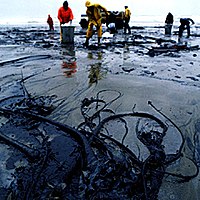
Photo from wikipedia
Abstract Bio-asphalt is a binding agent that is made of bio-oil and petroleum asphalt, or bio-oil modified with incorporations of some other additives under certain conditions. This study was carried… Click to show full abstract
Abstract Bio-asphalt is a binding agent that is made of bio-oil and petroleum asphalt, or bio-oil modified with incorporations of some other additives under certain conditions. This study was carried out to evaluate the properties of bio-asphalt binder-based in terms of the value of complex shear modulus (G∗) and the phase angle (δ) tested by dynamic shear rheometer (DSR). Four bio-oil dosages of 5, 10, 15, and 20% based on the weight of asphalt (S100) were used to alter the SBS-modified binder. Whereby, the SBS content is approximately 1% of the weight of the virgin asphalt. The complex shear modulus and frequencies of virgin and short-term aged binders were tested. The master curves of rutting factor (G∗/sinδ) of different bio-asphalt were then generated to survey its rheological properties in a broad range of frequencies and temperatures. Based on the results, it was found that the addition of bio-oil extracted from sawdust has significantly increased the complex shear modulus of asphalt binder at the same frequency conditions after going through rolling thin film oven (RTFO), which is desirable for rutting prevention of asphalt mixtures. The rheological properties of bio-binders are more susceptible to the RTFO aging condition compared to the reference binder. The master curve of rutting factor of bio-binder indicated that the rutting factor of bio-asphalt increased with the increase of frequency before and after RTFO. Additionally, incorporations of bio-oil into the SBS modified asphalt, has greatly increased the rutting factor (G∗/sinδ) after RTFO, regardless of the loading frequency. However, the degree of enhancement was dominated by the percentage of bio-oil and aging condition.
Journal Title: Construction and Building Materials
Year Published: 2018
Link to full text (if available)
Share on Social Media: Sign Up to like & get
recommendations!